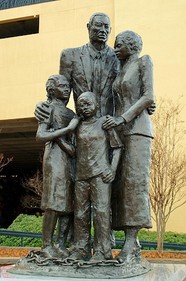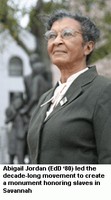Savannah's Slavery Monument
Introduction
Text-to-speech Audio
Images
Differing perspective about Maya Angelou's quote for the monument demonstrates the continuing differences of perspectives regarding the historical memory of slavery.

Ira Berlin, Many Thousands Gone: The First Two Centuries of Slavery in North America. Click on the link below for more information about this book

The monument was made possible by Dr. Abigail Jordan. Learn more about Jordan from the source of this image, The Bridge and the Monument: a Tale of Two Legacies, linked below.

Backstory and Context
Text-to-speech Audio
Retired professor Dr. Abigail Jordan worked for ten years and donated $100,000 to make the statue a reality. Savannah College of Art and Design Professor Dorothy Spradley and her student Dan Koster designed and built the monument.
The monument was finalized only after poet Maya Angelou accepted a compromise with Mayor Floyd Adams and other city leaders and influential citizens who were unsettled by Angelou's quote because of its graphic depiction of conditions within slave ships. In order to end their opposition and allow the monument's dedication to move forward, Angelou and Black leaders in Savannah agreed to "soften" the poet's quote by adding the final line "Today, we are standing up together, with faith and even some joy."
In 2001, Angelou explained why she and other Black leaders wanted to make sure that her original quote, which includes a reference to the unsanitary conditions slaves endured during the Middle Passage, was included on the monument. "The picture of it, it's so horrible. And yet if we can see how horrible it is, then we might treat each other a little nicer."
The inscription reads:
We were stolen, sold and bought together from the African continent. We got on the slave ships together. We lay back to belly in the holds of the slave ships in each others excrement and urine together, sometimes died together, and our lifeless bodies thrown overboard together. Today, we are standing up together, with faith and even some joy.
Angelou penned the final line and gave the city permission to modify her original quote to include this as on the monument so long as the rest of the quote was not modified.
Sources
Associated Press Wire, "Savannah Divided Over Monument," Los Angeles Times, Feb 10, 2001. http://articles.latimes.com/2001/feb/10/news/mn-23539.
Adams, Nordette. The Bridge and the Monument: a Tale of Two Legacies by. Accessed October 01, 2017. http://www.writingjunkie.net/bridge-monument.html.
